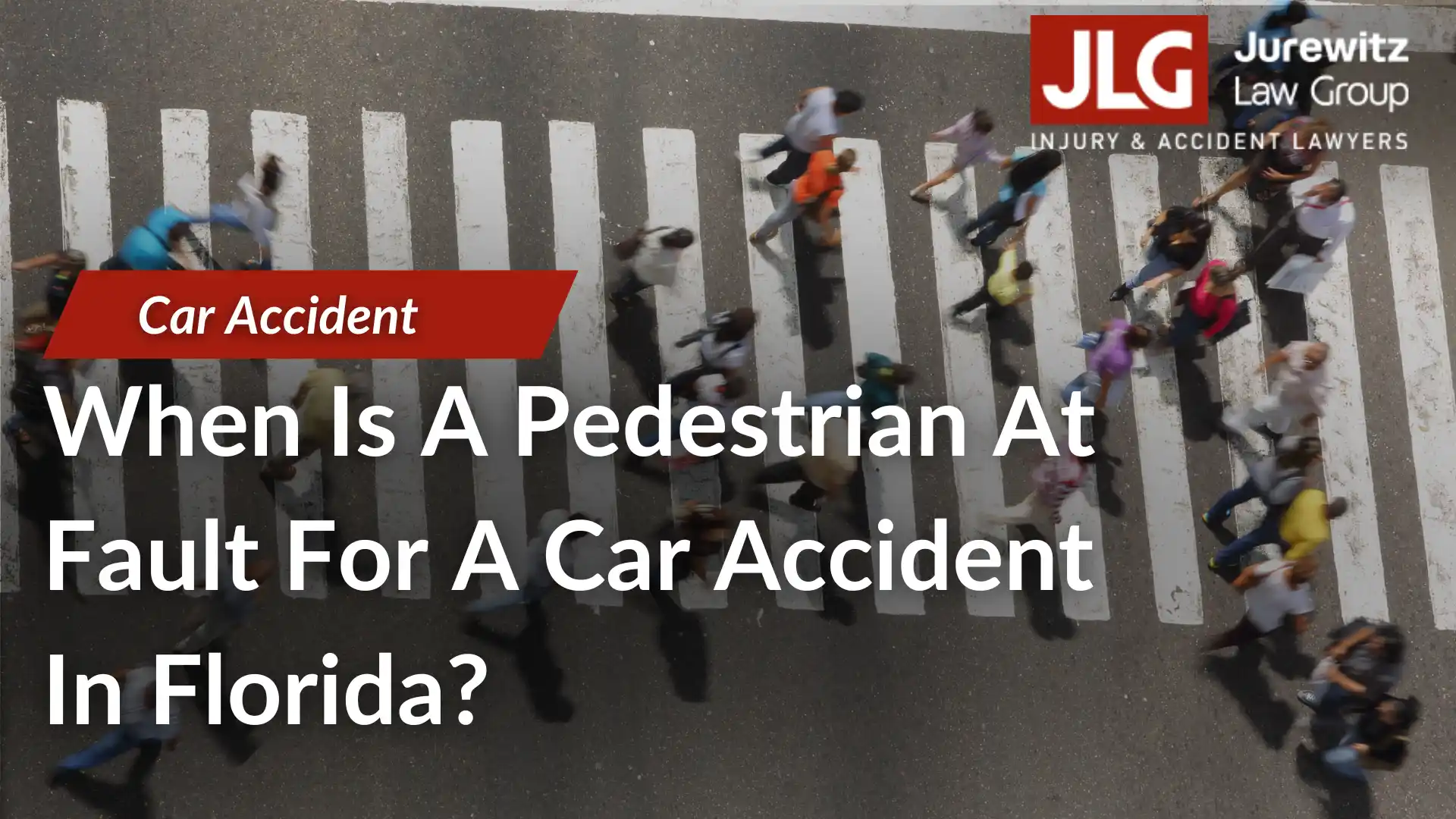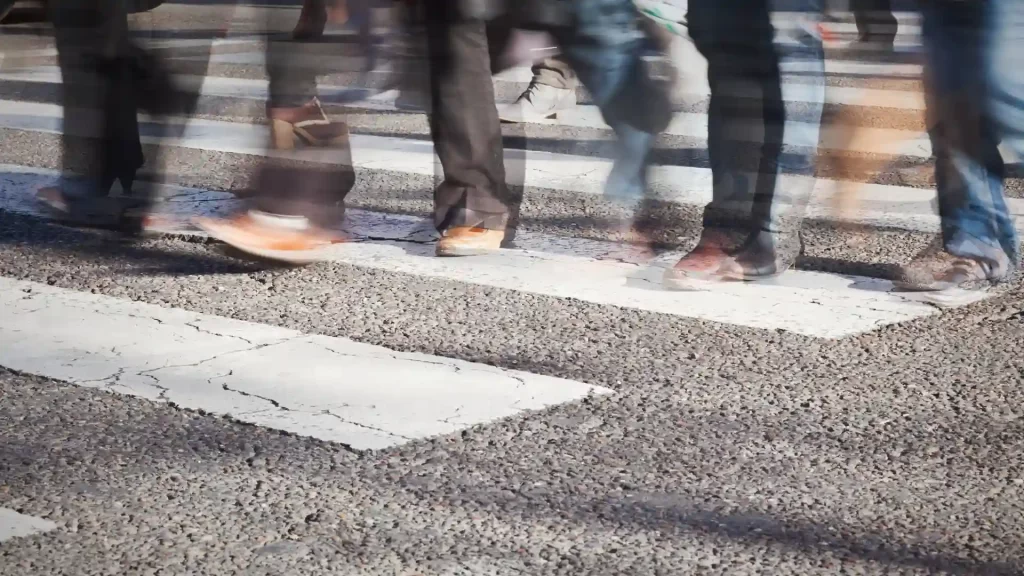
Don’t know when is a pedestrian at fault for a car accident? When a pedestrian is involved in a car accident, it’s often assumed that the driver is automatically at fault. However, there are situations in which a pedestrian may be held wholly or partially responsible for the incident.
In Florida, the concept of comparative negligence allows for the apportionment of fault between parties involved in an accident. A pedestrian’s actions can impact their ability to recover damages and may even result in them being held liable for the accident. We’ll explore the circumstances under which a pedestrian may be found at fault for a car accident in Florida, and discuss their legal implications.
Pedestrian Right-of-Way Laws in Florida
Pedestrian safety and laws in Florida can be complicated to figure out. Florida law establishes when pedestrians have the right-of-way and how they must generally behave to avoid putting themselves or others in harm’s way. Some of the key points to be aware of are crosswalk etiquette and right-of-way, risk and apportioning fault on dangerous acts, and intention of being in the scope of injury. When is a pedestrian at fault for a car accident if they follow right-of-way?
Crosswalk Etiquette and Right-of-Way
If a legal traffic control signal is present at an intersection, a pedestrian must obey it. A pedestrian must cross the street at a marked crosswalk between adjacent intersections with active traffic signals. A pedestrian generally must use the sidewalk when one is available. They may only walk on the paved area of the road if circumstances require doing so. A pedestrian should walk on the shoulder against the flow of traffic when no sidewalk is available. A pedestrian should use pedestrian tunnels or overhead pedestrian crossings when they are available.
A motorist must yield the right-of-way to a pedestrian in the crosswalk. Technically, a driver must stop if the pedestrian is in the crosswalk in their half of the road. A driver must also stop if they are so close to the crosswalk and they may cause a wreck. A pedestrian must always yield the right-of-way to vehicles in the roadway when crossing at any spot without a marked or unmarked crosswalk.
The intention of Being in the Scope of Injury
A pedestrian can’t suddenly leave a curb or other such area and run into the path of a vehicle when a vehicle would not have time to yield to the pedestrian. A pedestrian must always strive to cross a road in a manner that allows them to reach the opposite curb as quickly and safely as possible. However, when a crosswalk is available, using the crosswalk takes priority.
A pedestrian should stay to the right side/edge of a crosswalk whenever doing so is safe, possible, and practical. A pedestrian can’t cross a roadway diagonally unless a traffic signal indicates they can. Similarly, a pedestrian can’t enter a bridge or similar crossing when a gate or barrier prohibits other vehicles from entering. A pedestrian can’t walk upon a ramp or limited access facility leading to a street or highway. A pedestrian can’t jump or dive from a public bridge.
Familiarizing yourself with Florida pedestrian safety and laws is important. Abiding by these laws doesn’t just keep you safe—it can also help you show why you may deserve compensation after a collision.
When is a Pedestrian At Fault for a Car Accident?
A pedestrian may be at fault if a collision occurs because they broke a pedestrian safety law. According to the legal principle of negligence per se, if someone breaks a safety law and causes injury to others, they are automatically responsible for their injuries. When is a pedestrian at fault for a car accident in Florida? In Florida, the fault lies to whichever has a better percentage of fault for a car wreck, such as:
- A pedestrian who doesn’t have the right of way steps out into an intersection or the road in front of a vehicle. If the driver can’t stop in time, they may either collide with the pedestrian or another vehicle or object as they attempt to swerve out of the way.
- A pedestrian is walking while under the influence of drugs or alcohol. Some pedestrians don’t realize that walking around while drunk can be at least as dangerous as driving drunk. When they’re intoxicated, a pedestrian may be more likely to accidentally stumble off a sidewalk and into traffic. Or, they might fail to accurately gauge the distance of approaching vehicles when deciding whether to cross at a crosswalk.
- A pedestrian is engaging in reckless behaviors that may distract motorists or interfere with their ability to operate their vehicles. For example, a group of pedestrians engaging in horseplay could cause a dangerous situation if one of them were to push a fellow pedestrian out into the path of traffic. Even if this doesn’t happen, a driver might have to exercise additional caution when driving by them out of fear that something like this may occur.
Avoiding Danger
Pedestrians can and should take steps to make themselves more noticeable on the road. This is particularly important in low-light conditions. For example, a pedestrian may:
- Wear bright or reflective clothing
- Use their phone’s flashlight to indicate their position
- When possible, make eye contact with approach drivers before proceeding through crosswalks
Comparative Negligence in Pedestrian Accidents in Florida

Unsure of when is a pedestrian at fault for a car accident? Is it a pedestrian’s fault if a car accident in Florida is due to their carelessness? Florida’s comparative fault law may affect compensation in a pedestrian wreck. Per this law, a victim’s carelessness can influence how much compensation they may receive after a crash.
For instance, maybe you had the right-of-way and proceeded through a crosswalk when a speeding driver struck you. They may be to blame because they broke the law.
However, maybe you were looking at your phone and thus didn’t check for oncoming traffic when you entered the crosswalk. An insurance company or defendant might thus argue you don’t deserve as much compensation as you’re seeking because you could have avoided harm if you’d been paying attention.
The law states the proportion of blame assigned to a given party will influence how much compensation they may receive in these circumstances. Perhaps you could have received up to $10,000 in compensation had the party who primarily caused your injuries been exclusively to blame.
However, maybe you’re 25 percent responsible. The most compensation you may be eligible to receive in these circumstances is $7,500. You wouldn’t be eligible to receive any compensation if you were more than 50 percent responsible.
Contact a Florida Pedestrian Accident Lawyer
When is a pedestrian at fault for a car accident? Florida pedestrian accident claims and lawsuits are often complex. This is particularly true when they involve disputes over fault.
At Jurewitz Law Group Injury & Accident Lawyers, a Tampa pedestrian accident lawyer is available to review your personal injury case and answer your questions. Our personal injury lawyers can provide aggressive representation if you decide to work with us and help you get the best possible outcome. Learn when is a pedestrian at fault for a car accident by contacting us online or calling our firm at (619) 233-5020 for a free case review from our personal injury attorneys.


